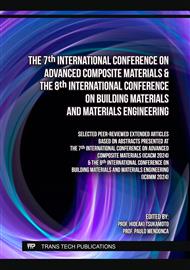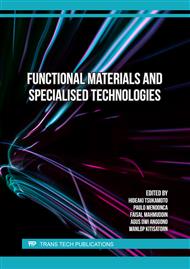p.17
p.23
p.33
p.39
p.47
p.55
p.61
p.67
p.73
Fabrication and Characterization of Acetic Acid-Treated Salago Fiber–Epoxy Composite: Enhancing Mechanical and Thermal Properties
Abstract:
In this paper, an experimental investigation of the effect of acetic acid treatment on the mechanical, thermal, and morphological properties of salago fiber composites is conducted. Salago fibers are natural fibers derived from a shrub native to the Philippines and other tropical countries. They have potential applications in the manufacturing industry as reinforcement materials for polymer composites, owing to their low cost, environmental friendliness, and lightweight. However, they also have some limitations, such as poor adhesion to the matrix and low resistance to biological degradation. To address these challenges, the salago fibers were pretreated with four different concentrations of acetic acid solution (0%, 5%, 10%, and 15%) and then neutralized with sodium hydroxide. The treated fibers were then combined with epoxy resin and fabricated into composite specimens. The specimens were tested for their tensile, flexural, impact, and thermal properties. The morphology and fracture behavior of the specimens were also examined using scanning electron microscopy. The results indicated that the optimal concentration of acetic acid treatment was 5%, which enhanced the fiber-matrix interface and improved the strength, stiffness, and thermal stability of the composite. The 5% acetic acid-treated fiber composites also exhibited better performance than the untreated fiber composites. The paper concludes that acetic acid treatment is a promising technique to improve the properties of salago fiber composites for various industrial applications.
Info:
Periodical:
Pages:
47-53
Citation:
Online since:
December 2024
Price:
Сopyright:
© 2024 Trans Tech Publications Ltd. All Rights Reserved
Share:
Citation:



